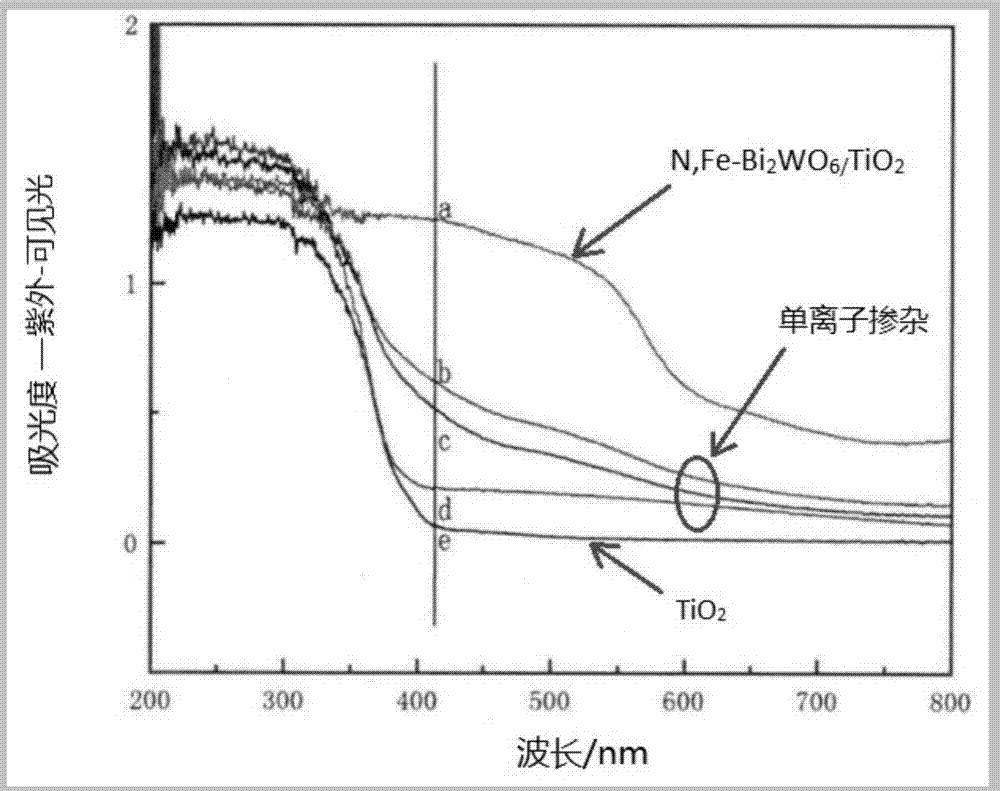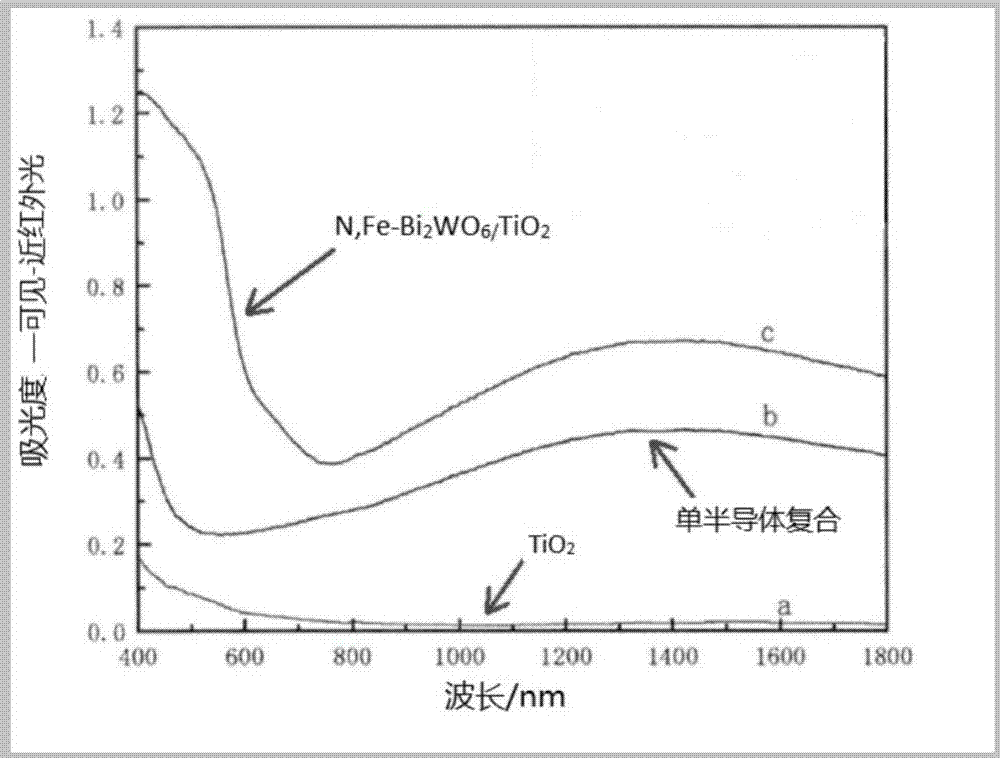Photocatalyst with broadband spectrum response and preparation method thereof
A photocatalyst and broad spectrum technology, applied in chemical instruments and methods, physical/chemical process catalysts, chemical/physical processes, etc., can solve the problems of insufficient light response range, low quantum efficiency of composite materials, etc., to improve catalytic performance , the effect of broadening the spectral response range and increasing the lifespan
- Summary
- Abstract
- Description
- Claims
- Application Information
AI Technical Summary
Problems solved by technology
Method used
Image
Examples
preparation example Construction
[0064] A preparation method of a photocatalyst with wide spectral response, the photocatalyst of described wide spectral response is nitrogen iron doped bismuth tungstate composite titanium dioxide nanomaterial, the preparation method of the photocatalyst of described wide spectral response is as follows:
[0065] 1. Prepare titanium dioxide nanomaterials; the titanium dioxide nanomaterials are titanium dioxide nanoparticles or titanium dioxide nanotubes;
[0066] 2. Doping titanium dioxide nanomaterials with iron and nitrogen;
[0067] 3. Preparation of nitrogen-iron-doped bismuth tungstate composite titanium dioxide nanomaterials.
[0068] Wherein, in the step 1), nano-titanium dioxide nanoparticles can be prepared by evaporation condensation method, sol-gel method, or hydrothermal method, or titanium dioxide nanotubes can be prepared by hydrothermal method, template method, anodic oxidation method, or crystal powder digestion method. However, the preparation of titania nan...
Embodiment 1
[0101] A photocatalyst with broad spectral response prepared by the following method:
[0102] 1. Preparation of titanium dioxide nanotubes
[0103] 1.1, the TiO 2 Dissolve the powder particles in 10mol / L NaOH solution, stir until fully mixed; TiO 2 The mass fraction in NaOH solution is 7%wt;
[0104] 1.2. Put the above solution into a high-pressure reaction kettle lined with polytetrafluoroethylene, keep the temperature at 160°C for 48 hours, and then cool it down to room temperature naturally;
[0105] 1.3. Put the cooled sample into a centrifuge for centrifugation, and then add deionized water until the pH value is near neutral;
[0106] 1.4. Wash the sample with a hydrochloric acid solution with a concentration of 0.1mol / L, and then wash the sample with deionized water until the pH value is near neutral;
[0107] 1.5. Use a centrifuge to separate and dry at 80°C to obtain titanium dioxide nanotubes;
[0108] 2. Doping titanium dioxide nanotubes with iron and nitrogen ...
Embodiment 2
[0118] 1. Preparation of titanium dioxide nanotubes
[0119] 1.1, the TiO 2 Dissolve the powder particles in 15mol / L NaOH solution, stir until fully mixed; TiO 2 The mass fraction in NaOH solution is 5%wt;
[0120] 1.2. Put the above solution into a high-pressure reaction kettle lined with polytetrafluoroethylene, keep the temperature at 180°C for 48 hours, and then cool it down to room temperature naturally;
[0121] 1.3. Put the cooled sample into a centrifuge for centrifugation, and then add deionized water until the pH value is near neutral;
[0122] 1.4. Wash the sample with a hydrochloric acid solution with a concentration of 0.1mol / L, and then wash the sample with deionized water until the pH value is near neutral;
[0123] 1.5. Use a centrifuge to separate and dry at 100°C to obtain titanium dioxide nanotubes;
[0124] 2. Doping titanium dioxide nanotubes with iron and nitrogen
[0125] 2.1. Put the titanium dioxide nanotubes prepared in step 1 into ferric nitrate...
PUM
| Property | Measurement | Unit |
|---|---|---|
| Concentration | aaaaa | aaaaa |
| Concentration | aaaaa | aaaaa |
Abstract
Description
Claims
Application Information
 Login to View More
Login to View More - Generate Ideas
- Intellectual Property
- Life Sciences
- Materials
- Tech Scout
- Unparalleled Data Quality
- Higher Quality Content
- 60% Fewer Hallucinations
Browse by: Latest US Patents, China's latest patents, Technical Efficacy Thesaurus, Application Domain, Technology Topic, Popular Technical Reports.
© 2025 PatSnap. All rights reserved.Legal|Privacy policy|Modern Slavery Act Transparency Statement|Sitemap|About US| Contact US: help@patsnap.com


